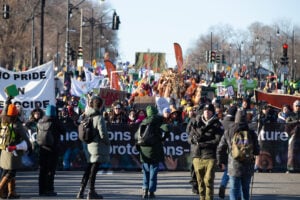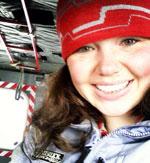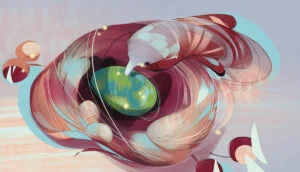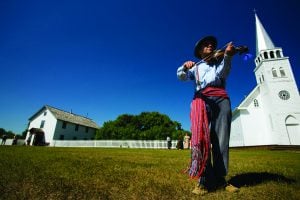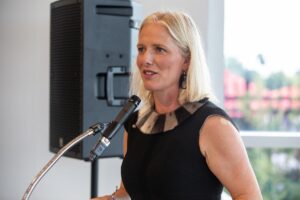Photo: My studio on the outskirts of Markham, is where I work as a multidisciplinary artist. Here in my element, I am free to explore my creativity.’ – Nava, born in Israel (Photo: Colin Boyd Shafer)
While living overseas, Colin Boyd Shafer was told again and again that he “looked Canadian.” This notion of a single Canadian ‘look’ was at odds with his experience growing up amid Toronto’s diversity. He decided to find and photograph someone from every country in the world who now calls Toronto home. He called the project Cosmopolis Toronto, and on Tuesday he launches a book that catalogues the first year.
How did you find the people?
It is important to note that many people helped in the process. Social media has been key. Many people don’t realize you can type in the Facebook search bar, “born in Tonga, living in Toronto” and find people that way. Also I tried searching for people by using hashtags on Twitter for the various countries.
Luckily the media took an interest in what I was doing, and after every radio, print or TV appearance I would receive more applications. My team and I also made a final attempt at finding people by creating posters with the missing countries on them and standing in Dundas Square.
What were the hardest countries to locate a representative for?
I should point out that I am still missing people from a few places. Comoros, East Timor, Monaco, Solomon Islands, San Marino, Kiribati, Nauru, Micronesia, Marshall Islands and Vanuatu. If anyone from these places is out there and living in the Greater Toronto Area… call me!
I did manage to find many people from countries that most people have never met someone from.
I was so happy when Elisaia from Tuvalu applied. It has a population of less than 10,000 people and I really didn’t expect to find someone from there.
Also I managed to find Gebhard from Liechtenstein. A gentleman saw me on Canada AM where I mentioned I was still missing a participant from Liechtenstein. He was out later that day and spotted a man he remembered talking to once and shouted from across the park, “Aren’t you from Liechtenstein? Someone is looking for you!” That evening he phoned me with Gebhard’s number.
What did you learn through the course of this project?
I think this project proved to me that anyone who has moved from one place to another has a story to tell. It is so important that we take the time to listen.
I think this project is also a reminder that our country was built on migration, and all of us have a connection to migration – whether it was recent or in the distant past. We can’t forget that, and that includes myself (the book is dedicated to my late Grandfather and my Grandmother Eileen who happens to be my participant born in the UK)
What’s next for you?
I am currently working on another portrait project that deals with diversity. This is a project on the love stories of interfaith couples in Ontario called INTERLOVE and it is wrapping up at the end of the summer. I have already photographed over fifty couples that are up at interloveproject.com and I plan on turning it into my next book.
‘After arriving in Toronto in the 1950s my wife Livia’s family decided, with some other Estonians, to pool their money and build a cooperative. On their own none of them would have had enough to buy a house. For this reason Livia and I have owned and lived in this Beaches apartment for over half of a century and continue her family’s legacy.’ – Gebhard, born in Liechtenstein (Photo: Colin Boyd Shafer)
‘While on tour in Japan, a Cuban official overheard me having a conversation with a fan about the detrimental effects of Hurricane Gustav on Cuba. The government official thought it reflected poorly on the country’s image and said I would be punished upon return. While on a layover in Toronto, I decided to never return to Cuba. Since then, performing in venues such as Lula Lounge has been crucial for my development as a successful violinist in Toronto.’ – Yosvani, born in Cuba (Photo: Colin Boyd Shafer)
‘The Don Valley Trail network is a where I often run and cycle. On my last outing, I rode all the way to Hamilton!’ – Mbalia, born in Sierra Leone (Photo: Colin Boyd Shafer)
‘Many amazing Tongan meals have been shared here in my sister Sosina’s Scarborough home, as we reminisce about our childhood in Tonga. I love how my sister’s house is filled with items from my birth country. Whenever any Tongans come to Canada, they always visit Sosina and she welcomes them with open arms.’ – Alisi, born in Tonga (Photo: Colin Boyd Shafer)
‘Ever since I took my first flight, from Georgetown to Toronto, I knew that I wanted to work in aviation. Today I work at Billy Bishop Airport as an executive with Porter Airlines.’ – Troy, born in Guyana (Photo: Colin Boyd Shafer)
‘I arrived in Toronto in 2009 on a dance scholarship with Ballet Creole. Today I work with different companies as a dancer, choreographer, model and teacher.’ – Hiba, born in Iraq (Photo: Colin Boyd Shafer)
‘Since I arrived in Canada, St. James Town has been home for my family. More than three hundred Nepalese families live in this area, and I find that comforting.’ – Mohan, born in Nepal (Photo: Colin Boyd Shafer)
‘My condo building in the Distillery District is a reminder of how far I have come since I fled the Rwandan genocide at the age of twelve.’ – Beni, born in Rwanda (Photo: Colin Boyd Shafer)
